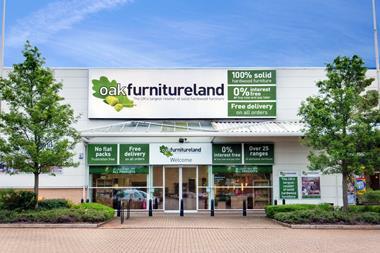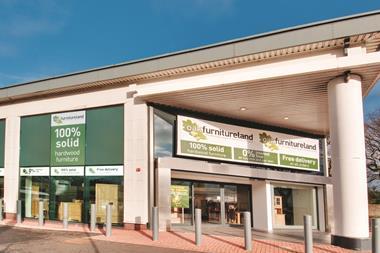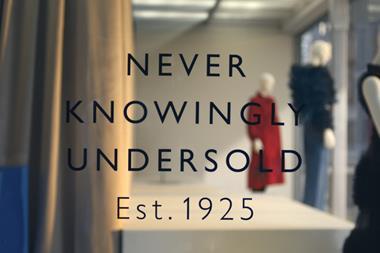Oak Furniture Land plans to open a shop every month for the next three years. Laura Heywood asks managing director Jason Bannister how the retailer has made the crossover from digital to physical stores.

In a climate where many retailers are downsizing to cut costs and focus on online growth, Oak Furniture Land stands out from the crowd. Not only has the hardwood furniture specialist made the transformation from a pure-play etailer to operating a physical store network, it is now focusing on rapidly increasing its profits from both its stores and online.
Oak Furniture Land began life as an eBay retailer in 2003. Set up by Bannister to flog a job lot of furniture, he soon realised there was good money to be made from furniture sales. However, its ‘distribution warehouse’ - a run-down chicken shed - just wasn’t large enough to meet demand.
Bannister needed to find a building big enough to suit his requirements, leading him to secure a lease on a vacant building in Chippenham, Wiltshire, which was to be demolished. The uncertain duration of the lease meant Bannister got a “fantastic deal” from commercial property agent Ashtenne, but the downside was the business could be thrown out with little notice.
At the time, paying rent at about £3 per sq ft on 5,000 sq ft of space was a daunting prospect for a business used to operating out of a shed. “We got the building at a price that frightened me to death then. Anything over £1 a sq ft was frightening - I earned in the region of £30,000 at the time working for a retail finance company,” Bannister says.
But the outlay was worth the risk becauseOak Furniture Land became eBay’s largest retailer within three years. “The online growth was so phenomenal it surprised even us,” Bannister says.
By 2006 and with a turnover of £2.7m, it was time for the retailer to move again. A 100,000 sq ft aircraft hangar in Kemble, Gloucestershire, became the etailer’s home, but not before some tough negotiations. “It took us quite a few months to get the sale done. We’re fair with people but we never pay over the odds. The deal that we had we were very happy with.”
The economic downturn also played into Oak Furniture Land’s favour, enabling it to get a cut-down rate. “If the climate wasn’t what it was, we wouldn’t have got the deal,” admits Bannister.
Having more space enabled the retailer to experiment with its first shop of sorts after Bannister noticed there was 13,000 sq ft of empty offices at the entrance to the airfield. “We asked the landlord if we could trial these as a showroom,” he says.
The Kemble showroom turned over £5m in its first year, proving that customers wanted to see and feel the furniture first hand. “At first we were worried the shop was cannibalising the web, but we soon realised we were still turning great figures online and having a shop was growing the business.”
From that realisation came the short step to opening a bespoke showroom in Cheltenham in 2010.
Since the opening of the first store, Oak Furniture Land has been on an aggressive acquisition drive, increasing its estate to 43 branches in out-of-town locations.
Bannister says it was hard at first to find units big enough to offer 10,000 sq ft of trading space and an 8,000 sq ft mezzanine. Landlords, unfamiliar with the retailer and its long-term objectives, were also reticent to lease prime space to an unknown and unproven name.
“When we first started opening stores, it was foreign to me - the agent was coming back to me in a diplomatic fashion [and saying units weren’t available or the deal wasn’t possible] - actually I think the landlord just didn’t want us,” Bannister recalls.
First in line
For the first 12 stores, Oak Furniture Land worked with Jones Lang LaSalle’s Steve Kettel to secure units, before Kettel moved to the company on a permanent basis as property director. “Nowadays, if there’s a place that’s a fantastic opportunity and there’s a queue of people for a unit, we’d like to think we’re at the top of the queue,” Bannister says.
Deciding where stores will be located is based on demand, Bannister explains. Think of it like a map of the UK, with a pin going in every time a customer orders furniture online, he explains. If there’s an area with lots of pins, but not many stores nearby, there’s a gap that needs filling.
Premium out-of-town retail parks are Oak Furniture Land’s bread and butter. But if space can’t be found there it’s been known to take stores in secondary locations on shorter leases to ensure the retailer is in a particular town.
Bannister has pledged to open one store a month for the next three years, with a minimum of 80 by the end of 2016.
While admitting the expansion plan “is far from cautious”, he also asserts “it’s well thought out”. “We will research to death whether or not it’s a good move for the business.”
Projections of 80 stores are also expected to be surpassed. “Anything we forecast we usually easily exceed,” he says, before adding the acquisition drive will only stop when there’s a store within half an hour’s drive from everyone living in England. “We’ll never get to the point where we say there’s too much to manage - it’s more the question if there’s actual need for it.”
Despite physical stores being vital for retailers selling “touchy-feely products” such as furniture, Bannister maintains that the website, which accounts for 30% of transactions, will remain central to the business. Last year, the website recorded a turnover of £30m while the stores notched up £60m.
“While there is a demand to buy our furniture we will do our very best to let the customer make their own mind up on how they wish to buy it,” he says.
Warehousing expansion
In 2012 the question of taking on more warehousing space reared its head again, but this time Bannister realised a new solution needed to be implemented. The decision to bring all Oak Furniture Land’s operations under one roof, and store and distribute its furniture from one location, was motivated by the desire to cut costs wherever possible.
“It offers fantastic economies of scale,” Bannister says of the 302,000 sq ft distribution warehouse in Swindon it took in November from IM Properties just three weeks after the terms were agreed.
Cushman & Wakefield and Jones Lang LaSalle acted as joint letting agents in what is heralded as one of the biggest deals in the distribution market in 2012. Speaking at the time, Cushman & Wakefield’s Gordon Reynolds said: “There is a shortage of good-quality distribution units across the UK, and DC2 with its 75m yard was one of the best in the country. The speed of this letting clearly demonstrates the strong levels of demand for quality standing product in key locations.”
Taking on the unit has resulted in significant cost savings for the retailer, according to Bannister. “Any extra costs have been stripped away - for example, we don’t have a wholesaler, we don’t use third-party carriers and all our people are in house.” Oak Furniture Land doesn’t even pay for expensive designers, choosing instead to do it themselves. “I am very lucky that my business is my hobby as well,” Bannister says.
Inside, the warehouse is “packed to the rafters”, meaning plans about how to store more stock are always front of mind. “At any one time I’d like to have 100,000 sq ft [of stock] on the water on container ships,” Bannister says.
Keeping a tight supply chain is imperative to success, he adds, especially given furniture has to be ordered five months in advance. This means careful forecasting, which Bannister admits “is a tricky thing to get correct”. But so far it’s working, with anticipated stock demand being pretty accurate, he says.


























1 Reader's comment